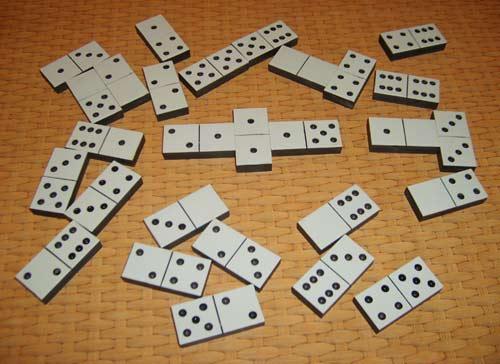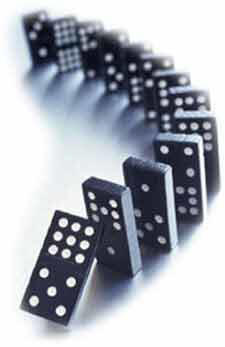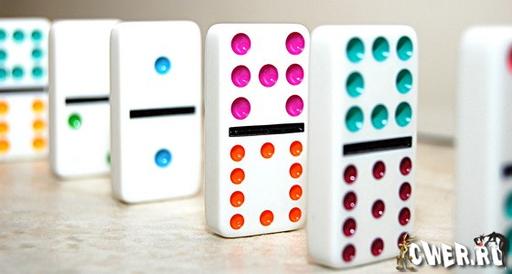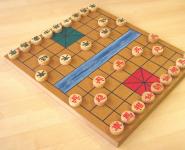Dominoes: Shall we rattle the bones?
Dominoes: Shall we rattle the bones?
Dominoes: Shall we rattle the bones?Dominoes is a game that came from ancient times, in which you need to build a chain of bones (also “bones” or “stones”), adding them by sides with the same point. In some Indonesian countries, dominoes are the national sport.
Description of the domino set
A typical set of dominoes contains 28 tiles, which are rectangular tiles. Their obverse is divided by a line into two identical ones, each of which contains from six to zero dots. There are special sets of dominoes in which the number of dots can be nine, twelve, fifteen or eighteen. On the reverse of the bone, some kind of drawing is usually depicted.
The dice themselves are made from bone (ivory or plain), plastic or wood, and sometimes a deck of cards is used instead. In addition to the traditional domino, there are other varieties of this game.
The number of bones in dominoes is calculated by the number of combinations of the number of dots according to the formula (n+1)×(n+2)/2, where n is the maximum number of points. Thus, a typical set of dominoes contains 28 tiles.
There are also other variants of dominoes. For example, in the Chinese set, which is the ancestor of the "western", there are 32 bones, but there are no "empty" parts in it, but there are several duplicates of paired bones.
History of dominoes
The forerunner of dominoes was an Indian game in which each tile represented the result of throwing two dice. Initially, this game was intended for the nobility and dominoes were made of ivory with ebony inserts. Now dominoes are usually made of black material with white accents.
Dominoes: Shall we rattle the bones?
 Dominoes: Shall we rattle the bones?
Dominoes: Shall we rattle the bones?
In the I-II centuries BC. the game was imported to China, and over time, about 50 more variants appeared on its basis - both with black and white knuckles, and with multi-colored ones. The games themselves have incredibly poetic names: "gazelle jump", "enter the pagoda", "carnations in the fog" and so on. Also, Chinese dominoes later developed into the game of Mahjong, popular in the United States in the 20s of the last century.
In Korea and India, dominoes are still used for divination. Such knuckles are considered sacred and have no other use.
In the 18th century, thanks to Marco Polo, dominoes appeared in Italy, where the bones shortened a little, got rid of various classes of bones and duplicates, and instead acquired seven additional bones with “empty” halves.
There is a version that the creation of dominoes belongs to the Dominican monks, since the clothes of the members of this order were called “dominoes” - a black cloak with a hood, and the name of the game of dominoes itself is the “offspring” of the Latin root “dominans”, meaning “dominating, chief", and which is the beginning of the appeal in Catholic worship: "Dominus vobiscum" ("God be with you").
There is a hypothesis that the main system of the world order was encrypted in dominoes - the Universal Law of Harmony of the macro- and microcosm: the game of dominoes has seven numbers (from 0 to 6), which, in particular, symbolizes the septenary structure of the Universe and the seven planes of being.
Rules of the game
The game is designed for two to four players. If two people play, they deal seven tiles each, and if three or four people play, five tiles each, the rest remain in reserve ("in the market"). The player who receives a double 6-6 or 0-0 (depending on the variation of the rules) starts the game. If neither player has received a 6-6 double, it is allowed to start playing with a 5-5 double and so on. If not a single double fell into the hands of the players, it is allowed to start the game with the bone with the highest number of points (for example, 5-6).
The next player must place a tile whose points on one half of the dice match the points already placed. If he does not have suitable bones, you need to take them “from the market”.
When one of the players puts the last bone, the game ends. Such an end is also likely - despite the knuckles remaining in their hands, the players cannot pick up anything to the already existing chain. This is called "fish", and the player who made the last move wins.
Then the points of the knuckles remaining on the hands are counted, and the sum of all points is counted to the winner. If the game ends with a “fish”, the winner is the player who left the knuckles with a smaller number of points in his hands, and the difference in the sum of points from the other players and his own is recorded as a win. You can play up to a predetermined number - one hundred or two hundred points.
Dominoes: Shall we rattle the bones?
 Dominoes: Shall we rattle the bones?
Dominoes: Shall we rattle the bones?Varieties of the game
In Russia, several variations of the game have become widespread, and the same variety in different areas and regions, as well as in different strata of society, may have different names and nuances of the rules.
I will designate the most common variants of the game of dominoes.
Goat
The most popular type of game designed for two to four players. Each is dealt 7 dominoes, and the first move is given to the player who received the double 1-1 or the other smallest one. It is forbidden to take the last bone "from the market". The next round is started by the winner of the previous one, or the one who arranged the "fish", and everyone else writes down the amount of points on their remaining dominoes, and you can start recording only with 13 points. The one who first scored 101 points is declared the loser - the "goat".
A common variant of the game is "pair for a pair" - 4 players are divided into 2 teams sitting diagonally opposite each other.
sea goat
Dominoes: Shall we rattle the bones?
 Dominoes: Shall we rattle the bones?
Dominoes: Shall we rattle the bones?
A complicated version of the usual goat. The game also involves 2-4 players, but four people must play in pairs.
The winner of the round records the sum of points on the dominoes of all other players.
The number of points with which you can start recording must be at least 25.
If someone else scored more than 25 points, then the score in the round is reset for everyone.
The player who scores 125 points wins.
The player can set up two doubles from both sides of the chain at the same time.
If the player who started to record points for himself starts the round with a double 6-6 (“by 100”) and wins it, he automatically becomes the winner of the game, but if he loses and has more than 24 points left in his hand, then he receives the title of "in-law" and loses the whole game.
The player who finishes the round with a 0-0 double wins the entire game and is called the "bald goat".
The player who finishes the round with a 6-6 double wins the game if the loser has more than 24 points. If the loser has less than 25 points, then the player who finished the round starts the next one with a double 6-6 (“one hundred”).
The player who at the end of the round has only a bone with a 0-0 double gets 25 points; a knuckle with a double 6-6 - 50 points; if he has two dominoes left with doubles 6-6 and 0-0, then he counts 75 points
The player who placed the “fish” is called the “fisherman”, and the double is not considered the last knuckle.
If the “fisherman” left less than 25 points in his hands, and the other players have more, then the “fisherman” is the winner of the round, and in the next he has the right to make a move “for 100”.
In case of winning by "fish" and if other players have 25 points or more left on dominoes, then this is called "decommissioned fish".
If the "fisherman" left more than 25 points in his hands and more than other players, then he can "write off the fish", and in the next round he has the right to go with any domino.
If the "fisherman" failed to write off the "fish" from three attempts, then he is considered the loser, and the right to move "for 100" passes to another player.
If both players have the same number of points in their hands during the “fish”, then the situation is called “eggs”.
- "Eggs" are played from a double 1-1.
If with "eggs" it was not possible to play them from three attempts, then they are considered "rotten" and the round is not counted.
sports domino
Another variation of the Goat for two pairs of players. Differences:
Rounds start in turn.
Knuckles should be placed on stands.
The number of rounds must be a multiple of four (4, 8, 12, etc.) and is agreed in advance.
The winner is the pair that recorded more points for the opponents.
Dominoes: Shall we rattle the bones?
Dominoes: Shall we rattle the bones?Donkey
Goat variation for 2-4 people. Differences:
Dominoes can be attached to the first double set from four sides, forming a cross and not a chain.
The player can put up several doubles on each side of the "cross".
When placing a double, you can “close” it, that is, by turning the domino upside down, forbid continuing this side of the “cross”. If a player puts up several doubles in one move, then he can open or close several ends of the "cross".
If the first domino placed is not a double, the next player can close two doubles at the same time, which usually ends the game and starts scoring.
The actual scoring is similar to the "goat" one - the game lasts up to 101 points, to start recording, you need to score at least 13. If the player scores less than 13, his score is "remembered" until the next round. If nothing is recorded or remembered in it for this player, the score is reset.
Phone (Flea; Houses)
This variation of the game differs from the rest in the way of scoring points.
The game involves either 2 players or 2 teams of 2 players, each is given 7 dominoes. The first double, which was closed on both sides, is called the "house", and now you can attach dominoes to it from four sides. The first round starts with the player who received the 2-3 domino, the next round starts with the player who won the previous one, and he has the right to start the game with any bone.
Points are awarded when the sum of points at different ends of the "cross" is a multiple of five.
The player left with dominoes deducts the remaining points for himself (also if they are a multiple of five, rounded down).
If teams play, points are collected and deducted from both team members.
The game goes up to 225 points and usually consists of 10-15 rounds. If both players/teams have scored 225 or more points, a draw is declared.
There is an option when in one move it is allowed to set up to 4 doubles - one on each side of the cross.
Dominoes: Shall we rattle the bones?
 Dominoes: Shall we rattle the bones?
Dominoes: Shall we rattle the bones?
Muggins
Variation of dominoes from England.
For two players, 7 dominoes are dealt, for three or four - 5 each. The first player can start with any knuckle. The first double opens the "cross", or four-way chain. Further dominoes can be attached from all four ends.
Points are awarded when the sum at the ends of the "cross" is a multiple of five.
The player who finishes the game receives ten points.
At the end of the “fish”, the winner is the player who left fewer points in his hand. He is recorded the difference in the sum of points from other players and his points (rounded up to five).
The game goes up to 200 points.
General goat
Variation for two teams of 2 players, which are located diagonally from each other (1.3 and 2.4). Each player is dealt 7 dominoes, the round starts with a double 1-1, the game is played in a "chain". The goal is to finish it with doubles 6-6 and/or 0-0, and players of the same team can signal each other about the doubles they have in their hands (for example, at 0-0 - you need to wink, at 6-6 - puff out your cheek).
You can not end the game with a "fish" - this round will not be considered.
The game ends if one of the players runs out of dominoes.
The loser is the player whose move must come after the player who laid out the last bone or double 0-0/6-6. He disturbs the dominoes for the next round and is declared the General.
Only the total number of "generals" per team is counted.
A variant of the game for three and four teams is possible - the team that received the "general" gives way to the waiting one.
There is a variation in which you can end the round only with a 0-0 double, and it is forbidden to prompt your partner.
Sausage
Domino variation for two people. Each player receives 14 tiles placed face down in a line. The first player takes one tile to the right from his line and places it on the table. It is possible that the game starts with a double, and in this way the players can get acquainted with their dominoes.
The meaning of the game is that it is necessary to build two lines from the first knuckle according to the rules of the classic domino. When two lines match in the number of dominoes, the player has the opportunity to "cut off the sausage", or, to put it more simply, to close his line with a transverse knuckle.
If the domino taken on the right is not suitable for the sausage, it is placed in the line of the player on the left and the turn passes to another player.
The round can end with a “fish” or when one of the players has no dominoes left, and the number of points remaining for him is recorded for the second.
It should be agreed in advance how many points the game goes to.
Domino principle
This is a chain distribution (chain reaction) of a certain phenomenon under the influence of some factor that affects the first element of the chain.
Special demonstrations of falling dominoes are held, usually to coincide with Domino Day, which has been held annually in the Netherlands since 1986. Competitions are organized there to build the longest possible demonstration chain, with colored dominoes they “draw” whole pictures!


